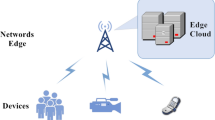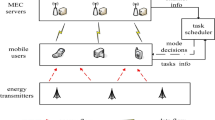Abstract
With the rapid development of intelligent devices, the intelligence of buildings is becoming more and more obvious, which leads to the rapid growth of data generated by building users. The existing network bandwidth is far from enough for the transmission of existing data, which will lead to congestion in the process of data transmission. In this paper, a task offloading strategy based on edge computing is proposed. The edge server is deployed near the data source, which mainly solves the problems of transmission delay and energy consumption of building users during task offloading. In this paper, the mathematical model of system delay and energy consumption is established first. In order to better reflect the quality of the system, the delay and energy consumption are combined into system utility, and then the objective function is established. Since the objective function is a mixed integer nonlinear programming problem, finding the optimal solution usually requires exponential time complexity. Therefore, this paper firstly uses the Tammer decomposition method to decouple the objective function, and decomposes it into the resource allocation problem of fixed task offloading decision and the task offload problem of maximizing the objective function. Then the convex optimization (CO) theory is used to greatly reduce the complexity of the objective function and optimize the resource allocation problem. Finally, the task offloading problem is solved by the improved Harris Hawks Optimization (HHO). The paper compares various offloading schemes. The simulation results show that the CO–HHO offloading strategy based on edge computing proposed in this paper can effectively reduce the transmission delay and energy consumption of user tasks in intelligent buildings, and is superior to others in all aspects.







Similar content being viewed by others
References
Bhattacharyya S, Misra A, Sarma KK (2019) DPLLs in wireless communication: current state and trends—a literature survey. J Inst Eng India Ser B 100(6):627–647
Index CVN (2017) Cisco visual networking index: forecast andmethodology 2016–2021. Complete Vis Networking Index(VNI)Forecast 12(1):749–759
Barua HB, Mondal KC (2019) Approximate computing: a survey of recent trends—bringing greenness to computing and commu-nication. J Inst Eng India Ser B 100(6):619–626
Liang B (2017) Key technologies for 5G wireless systems: mobile edge computing
Dinh TQ, Tang J, La QD et al (2017) Offloading in mobile edge computing: task allocation and computational frequency scaling. IEEE Trans Commun 65(8):3571–3584
Mukherjee A, Bose A, Chaudhuri DP et al (2021) Edge-based human activity recognition system for smart healthcare. J Inst Eng India Ser B 1–7
Wang J, Wang L (2021) Mobile edge computing task distribution and offloading algorithm based on deep reinforcement learning in internet of vehicles. J Amb Intel Human Comput 1–11
Ponmagal RS, Karthick S, Dhiyanesh B et al (2021) Optimized virtual network function provisioning technique for mobile edge cloud computing. J Amb Intel Hu-manized Comput 12(6):5807–5815
Wang S, Zhao Y, Xu J et al (2019) Edge server placement in mobile edge computing. J Parallel Distrib Comput 127:160–168
Mach P, Becvar Z (2017) Mobile edge computing: a survey on architecture and computation offloading. IEEE Commun Surv Tutor 19(3):1628–1656
Jiao L, Yin H, Huang H, Guo D, Lyu Y (2018) Computation offloading for multi-user mobile edge computing. In: 2018 IEEE 20th International conference on high performance computing and communications; IEEE 16th international conference on smart city; IEEE 4th international conference on data science and systems (HPCC/SmartCity/DSS), 422–429
Chen X, Jiao L, Li W et al (2016) Efficient multi-user computation offloading for mobile-edge cloud computing. IEEE/ACM Trans Networking 24(5):2795–2808
Mao YC, Xu XS, Liu PF (2021) Multi-user task offloading strategy based on stable allocation. J Comput Appl 41(03):786–793
Chen Z, Xu X, Wang HW, Luo HH, Chen X (2021) Optimization strategy for unloading power tasks in residential areas based on alternate edge nodes. J Zhejiang Univ Eng Sci 55(05):917–926
Liu J, Ren J, Zhang Y, Peng X, Zhang Y, Yang Y (2021) Efficient dependent task offloading for multiple applications in MEC-cloud system. IEEE Trans Mobile Comput. https://doi.org/10.1109/TMC.3119200
Yang L, Cao J, Wang Z, Wu W (2021) Network aware mobile edge computation partitioning in multi-user environments. IEEE Trans Serv Comput 14(5):1478–1491
Liu L, Huang H, Tan H, et al (2019) Online DAG scheduling with on-demand function configuration in edge computing. In: International conference on wireless algorithms, systems, and applications. Springer, Cham, 213–224
Li J, Liu Q, Wu P, et al (2018) Task offloading for UAV-based mobile edge computing via deep reinforcement learning. In: 2018 IEEE/CIC international conference on communications in China (ICCC). IEEE, 798–802
Alameddine HA, Sharafeddine S, Sebbah S et al (2019) Dynamic task offloading and scheduling for low-latency IoT services in multi-access edge computing. IEEE J Sel Areas Commun 37(3):668–682
Guo S, Liu J, Yang Y et al (2018) Energy-efficient dynamic computation offloading and cooperative task scheduling in mobile cloud computing. IEEE Trans Mob Comput 18(2):319–333
Long L, Liu Z, Zhou Y, et al (2019) Delay optimized computation offloading and resource allocation for mobile edge computing. In: 2019 IEEE 90th vehicular technology conference (VTC2019-Fall). IEEE, 1–5
Vanchinathan K, Valluvan KTR, Gnanavel C, et al (2021) An improved incipient whale optimization algorithm based robust fault detection and diagnosis for sensorless brushless DC motor drive under external disturbances. Int Trans Electr Energy Syst 13251
Kumarasamy V, Ramasamy V K T, Chinnaraj G (2021) Systematic design of multi-objective enhanced genetic algorithm optimized fractional order PID controller for sensorless brushless DC motor drive. Circuit World
Wang Y, Ge H, Feng A, et al (2020) Computation offloading strategy based on deep reinforcement learning in cloud-assisted mobile edge computing. In: 2020 IEEE 5th international conference on cloud computing and big data analytics (ICCCBDA). IEEE, 108–113
Li X, Zang Z, Shen F et al (2020) Task offloading scheme based on improved contract net protocol and beetle antennae search algorithm in fog computing networks. Mobile Networks Appl 25(6):2517–2526
Ma S, Song S, Yang L et al (2021) Dependent tasks offloading based on particle swarm optimization algorithm in multi-access edge computing. Appl Soft Comput 112:107790
Pochet Y, Wolsey LA (2006) Production planning by mixed integer programming. Springer
Tammer K (1987) The application of parametric optimization and imbedding to the foundation and realization of a generalized primal decomposition approach
Du Y, De Veciana G (2014) Wireless networks without edges: dynamic radio resource clustering and user scheduling. In: IEEE INFOCOM 2014-IEEE conference on computer communications. IEEE, 1321–1329
Bereanu B (1972) Quasi-convexity, strictly quasi-convexity and pseudo-convexity of composite objective functions. Revue française d'automatique informatique recherche opérationnelle. Mathématique 6(R1):15–26
Gordon G, Tibshirani R (2012) Karush-kuhn-tucker conditions. Optimization 10(725/36):725
Aaha B, Sm C, Hf D et al (2019) Harris hawks optimization: algorithm and applications. Future Gener Comput Syst 97:849–872
Moustafa M, Mohd MH, Ismail AI et al (2018) Dynamical analysis of a fractional-order Rosenzweig–MacArthur model incorporating a prey refuge. Chaos, Solitons Fractals 109:1–13
Chu, Xiao L, et al (2013) Heterogeneous cellular networks: theory, simulation and deployment. Cambridge University Press
Zhao J, Li Q, Gong Y et al (2019) Computation offloading and resource allocation for cloud assisted mobile edge computing in vehicular networks. IEEE Trans Veh Technol 68(8):7944–7956
Funding
National Natural Science Foundation of China, 61572416, Yi Lingzhi, Hunan province Natural science Zhuzhou United foundation,2020JJ6009, Yi Lingzhi, Postgraduate Scientific Research Innovation Project of Hunan Province, Key Laboratory Open Project Fund of Disaster Prevention and Mitigation for Power Grid Transmission and Transformation Equipment.
Author information
Authors and Affiliations
Corresponding author
Ethics declarations
Conflict of interest
The author(s) declared no potential conflicts of interest with respect to the research, authorship, and/or publication of this article.
Additional information
Publisher's Note
Springer Nature remains neutral with regard to jurisdictional claims in published maps and institutional affiliations.
Rights and permissions
About this article
Cite this article
Yi, L., Gao, X., Li, Z. et al. Task Offloading of Intelligent Building Based on CO–HHO Algorithm in Edge Computing. J. Electr. Eng. Technol. 17, 3525–3539 (2022). https://doi.org/10.1007/s42835-022-01108-0
Received:
Revised:
Accepted:
Published:
Issue Date:
DOI: https://doi.org/10.1007/s42835-022-01108-0




